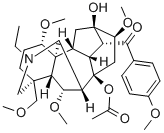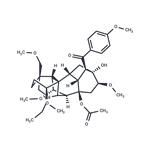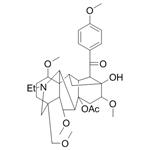Bulleyaconitine A is an aconitine-type two terpene alkaloid, and its molecular formula is C35H49NO10.?As early as 1980, bulleyaconitine was separated and extracted
from a traditional analgesic and anti-inflammatory herb in the west of Yunnan called
dianxi dula (or dianxi wutou) (Aconitum bulleyanum Diels), by the Kunming
Institute of Botany, Chinese Academy of Sciences . At present, bulleyaconitine A
can be separated from Aconitum plants, for example, dianxi wutou (Aconitum bulleyanum Diels), cujing wutou (Aconitum crassicaule W.T.?Wang), changhui wutou
(Aconitum georgei Comber), and zhiyuan wutou (Aconitum transsectum Diels).
Appearance: white powder. Solubility: soluble in methanol, ethanol, chloroform,
and ether; insoluble in water; and easily dissolved in dilute hydrochloric acid or
dilute sulfuric acid . Melting point: 160–165?°C
In 1983, it was confirmed that bulleyaconitine A shows obvious analgesic and antiinflammatory effects by preclinical pharmacological tests . Clinical trials were
carried out in 29 hospitals in 9 provinces in 1984. Bulleyaconitine A passed technical appraisals in May 1985 and was first formally put into production by Yunnan
Honghe Pingbian pharmaceutical company, where it obtained the trade name
“Bulleyaconitine A.” Bulleyaconitine A has been listed into the Pharmacopoeia of
the People’s Republic of China (2015). In recent years, bulleyaconitine A has shown
a great market growth and competitive power, owing to its exact curative effect and
rapid clinical promotion in chronic disease and rheumatic immune disease.
Bulleyaconitine A is an agent that expresses long-lasting local anaesthetic properties used in the treatment of chronic pain and arthritis. Commonly used in China as a traditional medicine.
1. Anti-inflammatory and analgesic effect. Bulleyaconitine A plays a significant
anti-inflammatory effect by inhibiting the release of prostaglandins. The analgesic effect may be related to the rivalry of 5-HT and the inhibition of inflammatory
chemokines in the brain, because inhibition of PGE2 release may lead to disinhibition of β-endorphin . Further studies showed that bulleyaconitine A achieved
the analgesic effect by effectively reducing sodium ion current, the electrophysiological basis on which pain conduction is dependent . Zhanguo Niu et?al.
found that bulleyaconitine A could be used to treat mild and moderate burn pain,
with less adverse reactions and no addiction . Thus, bulleyaconitine A may be
suitable for long-term use as a choice of analgesic therapy for burn pain. Recently,
through clinical observation on the effect of bulleyaconitine A treatment in acute
gouty arthritis, some scholars discovered that bulleyaconitine A brought about
good effect and could effectively improve the clinical symptoms of patients by
taking 0.4?mg bulleyaconitine A orally three times in daily .
2. Immune regulation. Bulleyaconitine A has obvious inhibitory effects to immune
cells involved in joint inflammation, which may have a close relationship to its
clinical anti-inflammatory effect. Ye Lu et?al. studied the influence of bulleyaconitine A on partial immune functions of BALB/c mice and found that 0.32?mg/kg
bulleyaconitine A inhibits some immune functions of BALB/c mice . Moreover,
it was reported that bulleyaconitine A significantly inhibited the phagocytic function and the ability to secrete nitric oxide (NO) of macrophages .
3. Other pharmacological effects. An injection of 0.1 mg/kg bulleyaconitin A in
fasting rat can inhibit the formation of corneal neovascularization induced by
alkali burn . Bulleyaconitine A also has local anesthesia and antipyretic effect.
Besides, bulleyaconitine A can be used for the treatment of lumbar muscle strain,
scapulohumeral periarthritis, and sprain of limbs.
1. Rheumatic immune disease. Since listing, bulleyaconitine A has been applied in
clinical treatment for rheumatoid arthritis and osteoarthritis, receiving good
curative effects.
2. Chronic pain. Bulleyaconitine A does not belong to NSAID, and it exerts its
effects by regulating the sodium ion channel. So there is little psychological
dependence and organ toxicity, avoiding gastrointestinal/cardiovascular/renal
adverse reactions and drug dependence or other potential dangers caused by
NSAID and opioid analgesics.



